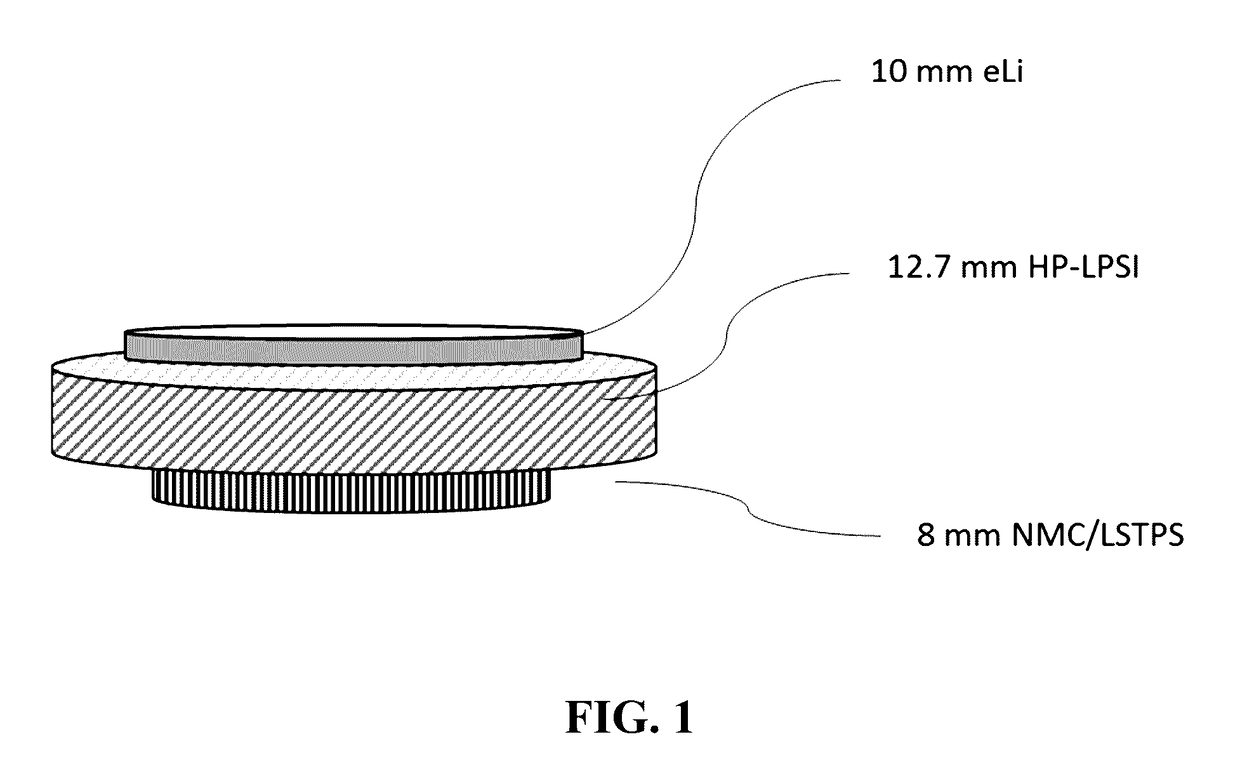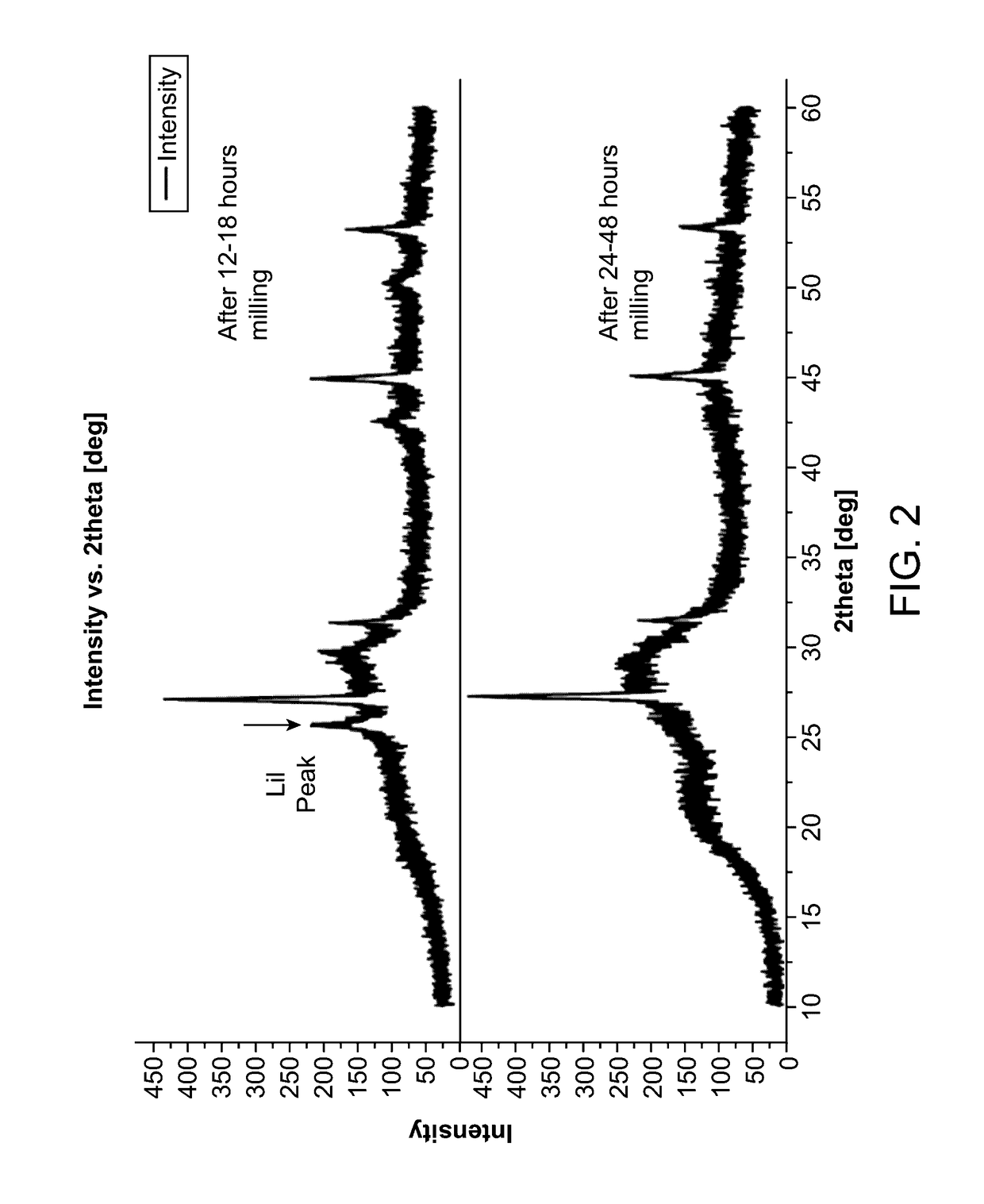Lithium, phosphorus, sulfur, and iodine including electrolyte and catholyte compositions, electrolyte membranes for electrochemical devices, and annealing methods of making these electrolytes and catholytes
a technology which is applied in the field of lithium, phosphorus, sulfur and iodine including electrolyte and catholyte compositions, electrolyte membranes for electrochemical devices, and annealing methods of making these electrolytes and catholytes. it can solve the problems of high cost and limited performance of conventional rechargeable batteries, which are the main obstacles to mainstream adoption of electric vehicl
- Summary
- Abstract
- Description
- Claims
- Application Information
AI Technical Summary
Benefits of technology
Problems solved by technology
Method used
Image
Examples
example 1
Making Lithium-Phosphorus-Sulfur-Iodine (“LPSI”)
[0137]To formulate the Lithium-Phosphorus-Sulfur-Iodine (LPSI) ion conductor, lithium sulfide (Li2S), phosphorus pentasulfide (P2S5), and lithium iodide (LiI) were mixed in a predetermined ratio. In one sample, lithium sulfide (Li2S), phosphorus pentasulfide (P2S5), and lithium iodide (LiI) were mixed in a (3-4):(0.1-1):(0.5-1.5) mole ratio in a 500 ml zirconia milling jar with 1 mm zirconia milling media at a milling media:powder mass ratio of >7.5. The mixture was agitated in a planetary mill (Retsch PM400, 150 mm revolution radius, 1:2 speed ratio) for sixteen to thirty-six 16-32 hours. As shown in FIG. 2, milling the precursors for about twelve (12) to eighteen (18) hours resulted in a precursor mixture in which crystalline lithium iodide (LiI) was observable. Also as shown in FIG. 2, milling the precursors for about twenty-four (24) to four-eight (48) hours resulted in a precursor mixture in which crystalline lithium iodide (LiI) ...
example 2
nity of LPSI as a Function of the Annealing Temperature
[0142]The air-sensitive sulfide sample was loaded level into an air-tight Kapton film dome holder and measured with our Rigaku MiniFlex II X-ray Diffractometer. The diffractometer was set up with a 1.25 degree divergence and scattering slit, as well as a 0.3 mm receiving slit, with a graphite monochromator on our copper k-alpha x-ray tube. Samples were scanned from 10-60 degrees at 30 kV and 15 mA, with a sampling width of 0.020 degrees at a speed of 1.00 degrees / min.
[0143]As shown in FIG. 4, each sample from Example 1 which was annealed at a different annealing temperature was observed to have a unique XRD pattern associated with it. As shown in FIG. 4, the LPSI material annealed at 190° C. was characterized by an x-ray powder diffraction (XRD) pattern having the following reflections at: 20, 25, 27, 29, and 45±1° (2Θ). As shown in FIG. 4, the LPSI material annealed at 170° C. is characterized by an x-ray powder diffraction (XR...
example 3
Li Ion Conductivity in LPSI Annealed at Different Temperatures
[0148]LPSI compositions were prepared according to Example 1 and annealed at either 170° C., 180° C., 190° C., 210° C., 230° C., 250° C., 270° C., for 2-8 hours. The annealing conditions included an Argon atmosphere.
[0149]Pellets of LPSI were prepared. Electrical impedance spectroscopy (EIS) was used to measure the impedance of the LPSI materials.
[0150]As shown in FIG. 5, the conductivity of the LPSI materials is a function of the temperature at which the LPSI materials are annealed. As shown in FIG. 5, the highest conductivity was observed for the LPSI materials which were annealed at 190° C. LPSI materials annealed at 190° C. were observed to have a conductivity between 3-4×10−3 S / cm. LPSI materials annealed at temperatures above or below 190° C. were observed to have a lower ionic conductivity than the LPSI materials annealed at 190° C.
PUM
 Login to View More
Login to View More Abstract
Description
Claims
Application Information
 Login to View More
Login to View More - R&D
- Intellectual Property
- Life Sciences
- Materials
- Tech Scout
- Unparalleled Data Quality
- Higher Quality Content
- 60% Fewer Hallucinations
Browse by: Latest US Patents, China's latest patents, Technical Efficacy Thesaurus, Application Domain, Technology Topic, Popular Technical Reports.
© 2025 PatSnap. All rights reserved.Legal|Privacy policy|Modern Slavery Act Transparency Statement|Sitemap|About US| Contact US: help@patsnap.com



